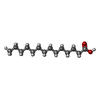+ データを開く
データを開く
- 基本情報
基本情報
| 登録情報 | データベース: PDB / ID: 3iyl | ||||||
|---|---|---|---|---|---|---|---|
| タイトル | Atomic CryoEM Structure of a Nonenveloped Virus Suggests How Membrane Penetration Protein is Primed for Cell Entry | ||||||
 要素 要素 |
| ||||||
 キーワード キーワード | VIRUS / Non-enveloped virus / Membrane penetration protein / Autocleavage / Myristol Group / Icosahedral virus | ||||||
| 機能・相同性 |  機能・相同性情報 機能・相同性情報symbiont entry into host cell via permeabilization of inner membrane / permeabilization of host organelle membrane involved in viral entry into host cell / viral inner capsid / host cell surface binding / viral outer capsid / 7-methylguanosine mRNA capping / viral capsid / mRNA guanylyltransferase activity / mRNA 5'-cap (guanine-N7-)-methyltransferase activity / hydrolase activity ...symbiont entry into host cell via permeabilization of inner membrane / permeabilization of host organelle membrane involved in viral entry into host cell / viral inner capsid / host cell surface binding / viral outer capsid / 7-methylguanosine mRNA capping / viral capsid / mRNA guanylyltransferase activity / mRNA 5'-cap (guanine-N7-)-methyltransferase activity / hydrolase activity / RNA helicase activity / RNA helicase / GTP binding / ATP binding / metal ion binding 類似検索 - 分子機能 | ||||||
| 生物種 |  Grass carp reovirus (ウイルス) Grass carp reovirus (ウイルス) | ||||||
| 手法 | 電子顕微鏡法 / 単粒子再構成法 / クライオ電子顕微鏡法 / 解像度: 3.3 Å | ||||||
 データ登録者 データ登録者 | Zhang, X. / Jin, L. / Fang, Q. / Hui, W. / Zhou, Z.H. | ||||||
 引用 引用 |  ジャーナル: Cell / 年: 2010 ジャーナル: Cell / 年: 2010タイトル: 3.3 A cryo-EM structure of a nonenveloped virus reveals a priming mechanism for cell entry. 著者: Xing Zhang / Lei Jin / Qin Fang / Wong H Hui / Z Hong Zhou /  要旨: To achieve cell entry, many nonenveloped viruses must transform from a dormant to a primed state. In contrast to the membrane fusion mechanism of enveloped viruses (e.g., influenza virus), this ...To achieve cell entry, many nonenveloped viruses must transform from a dormant to a primed state. In contrast to the membrane fusion mechanism of enveloped viruses (e.g., influenza virus), this membrane penetration mechanism is poorly understood. Here, using single-particle cryo-electron microscopy, we report a 3.3 A structure of the primed, infectious subvirion particle of aquareovirus. The density map reveals side-chain densities of all types of amino acids (except glycine), enabling construction of a full-atom model of the viral particle. Our structure and biochemical results show that priming involves autocleavage of the membrane penetration protein and suggest that Lys84 and Glu76 may facilitate this autocleavage in a nucleophilic attack. We observe a myristoyl group, covalently linked to the N terminus of the penetration protein and embedded in a hydrophobic pocket. These results suggest a well-orchestrated process of nonenveloped virus entry involving autocleavage of the penetration protein prior to exposure of its membrane-insertion finger. | ||||||
| 履歴 |
|
- 構造の表示
構造の表示
| ムービー |
 ムービービューア ムービービューア |
|---|---|
| 構造ビューア | 分子:  Molmil Molmil Jmol/JSmol Jmol/JSmol |
- ダウンロードとリンク
ダウンロードとリンク
- ダウンロード
ダウンロード
| PDBx/mmCIF形式 |  3iyl.cif.gz 3iyl.cif.gz | 1.8 MB | 表示 |  PDBx/mmCIF形式 PDBx/mmCIF形式 |
|---|---|---|---|---|
| PDB形式 |  pdb3iyl.ent.gz pdb3iyl.ent.gz | 1.5 MB | 表示 |  PDB形式 PDB形式 |
| PDBx/mmJSON形式 |  3iyl.json.gz 3iyl.json.gz | ツリー表示 |  PDBx/mmJSON形式 PDBx/mmJSON形式 | |
| その他 |  その他のダウンロード その他のダウンロード |
-検証レポート
| 文書・要旨 |  3iyl_validation.pdf.gz 3iyl_validation.pdf.gz | 1.5 MB | 表示 |  wwPDB検証レポート wwPDB検証レポート |
|---|---|---|---|---|
| 文書・詳細版 |  3iyl_full_validation.pdf.gz 3iyl_full_validation.pdf.gz | 2.6 MB | 表示 | |
| XML形式データ |  3iyl_validation.xml.gz 3iyl_validation.xml.gz | 417.8 KB | 表示 | |
| CIF形式データ |  3iyl_validation.cif.gz 3iyl_validation.cif.gz | 592.2 KB | 表示 | |
| アーカイブディレクトリ |  https://data.pdbj.org/pub/pdb/validation_reports/iy/3iyl https://data.pdbj.org/pub/pdb/validation_reports/iy/3iyl ftp://data.pdbj.org/pub/pdb/validation_reports/iy/3iyl ftp://data.pdbj.org/pub/pdb/validation_reports/iy/3iyl | HTTPS FTP |
-関連構造データ
- リンク
リンク
- 集合体
集合体
| 登録構造単位 | 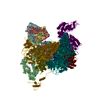
|
|---|---|
| 1 | x 60
|
| 2 |
|
| 3 | x 5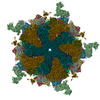
|
| 4 | x 6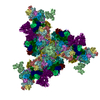
|
| 5 | 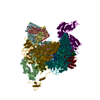
|
| 対称性 | 点対称性: (シェーンフリース記号: I (正20面体型対称)) |
- 要素
要素
| #1: タンパク質 | 分子量: 68646.750 Da / 分子数: 20 / 由来タイプ: 天然 / 由来: (天然)  Grass carp reovirus (ウイルス) / 参照: UniProt: Q8JU67 Grass carp reovirus (ウイルス) / 参照: UniProt: Q8JU67#2: タンパク質 | 分子量: 44606.535 Da / 分子数: 2 / 由来タイプ: 天然 / 由来: (天然)  Grass carp reovirus (ウイルス) / 参照: UniProt: Q8JU64 Grass carp reovirus (ウイルス) / 参照: UniProt: Q8JU64#3: タンパク質 | | 分子量: 141512.156 Da / 分子数: 1 / 由来タイプ: 天然 / 由来: (天然)  Grass carp reovirus (ウイルス) / 参照: UniProt: Q9E3W0 Grass carp reovirus (ウイルス) / 参照: UniProt: Q9E3W0#4: タンパク質 | 分子量: 132203.312 Da / 分子数: 2 / 由来タイプ: 天然 / 由来: (天然)  Grass carp reovirus (ウイルス) / 参照: UniProt: Q9E3V8 Grass carp reovirus (ウイルス) / 参照: UniProt: Q9E3V8#5: 化合物 | ChemComp-MYR / Has protein modification | Y | |
|---|
-実験情報
-実験
| 実験 | 手法: 電子顕微鏡法 |
|---|---|
| EM実験 | 試料の集合状態: PARTICLE / 3次元再構成法: 単粒子再構成法 |
- 試料調製
試料調製
| 構成要素 | 名称: Aquareovirus / タイプ: VIRUS / 詳細: The sample was monodisperse |
|---|---|
| 分子量 | 値: 72 MDa / 実験値: NO |
| ウイルスについての詳細 | 中空か: NO / エンベロープを持つか: NO / ホストのカテゴリ: VERTEBRATES / 単離: STRAIN / タイプ: VIRION |
| 緩衝液 | pH: 7.5 / 詳細: 10mM PBS Buffer |
| 試料 | 包埋: NO / シャドウイング: NO / 染色: NO / 凍結: YES / 詳細: 10mM PBS Buffer |
| 急速凍結 | 装置: FEI VITROBOT MARK I / 凍結剤: METHANE / Temp: 90 K / 湿度: 100 % / 手法: Blot for 7-9 seconds before plunging |
- 電子顕微鏡撮影
電子顕微鏡撮影
| 実験機器 |  モデル: Titan Krios / 画像提供: FEI Company |
|---|---|
| 顕微鏡 | モデル: FEI TITAN KRIOS / 日付: 2009年3月1日 |
| 電子銃 | 電子線源:  FIELD EMISSION GUN / 加速電圧: 300 kV / 照射モード: FLOOD BEAM FIELD EMISSION GUN / 加速電圧: 300 kV / 照射モード: FLOOD BEAM |
| 電子レンズ | モード: BRIGHT FIELD / 倍率(公称値): 59000 X / 倍率(補正後): 57700 X / 最大 デフォーカス(公称値): 2700 nm / 最小 デフォーカス(公称値): 400 nm / Cs: 2.7 mm 非点収差: objective lens astigmatism was corrected at 250,000 times magnification カメラ長: 0 mm |
| 試料ホルダ | 試料ホルダーモデル: OTHER / 資料ホルダタイプ: Eucentric / 温度: 90 K / 最低温度: 90 K / 傾斜角・最大: 0 ° / 傾斜角・最小: 0 ° |
| 撮影 | 電子線照射量: 25 e/Å2 / フィルム・検出器のモデル: KODAK SO-163 FILM |
| 放射 | プロトコル: SINGLE WAVELENGTH / 単色(M)・ラウエ(L): M |
| 放射波長 | 相対比: 1 |
- 解析
解析
| EMソフトウェア |
| ||||||||||||
|---|---|---|---|---|---|---|---|---|---|---|---|---|---|
| CTF補正 | 詳細: Each particle | ||||||||||||
| 対称性 | 点対称性: I (正20面体型対称) | ||||||||||||
| 3次元再構成 | 手法: Fourier Space Reconstruction / 解像度: 3.3 Å / 解像度の算出法: FSC 0.143 CUT-OFF / 粒子像の数: 18464 / 対称性のタイプ: POINT | ||||||||||||
| 精密化ステップ | サイクル: LAST
|
 ムービー
ムービー コントローラー
コントローラー





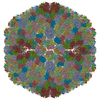


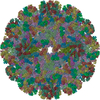
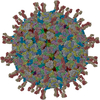
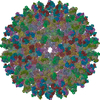
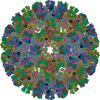
 PDBj
PDBj







